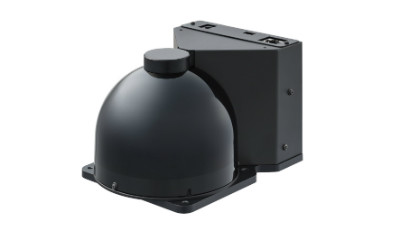Panasonic Develops 3D LiDAR Sensor...
October 02, 2017
on
on

...Enabling 3D Detection of Distances with Wide Angle of View
Enables stable operations of autonomous robots
Panasonic Industry Europe announced Panasonic Corporation has developed a 3D LiDAR (Light Detection and Ranging)
Sensor equipment that measures distance between the equipment and the object from the round-trip travelling time of the pulse laser that is projected to the object. sensor that accurately measure the direction of and distance to objects with a wide angle of view, which is critical for autonomous operation of mobile robots. Employing Panasonic’s propriety laser-scanning technology, this 3D LiDAR is capable of scanning the laser as wide as up to 60 degrees vertically and 270 degrees horizontally to achieve stable operation of autonomous robots. Sample shipments will start in January 2018.
The wide scanning angle of the newly developed 3D LiDAR helps the detection of objects on the ground precisely as well as the roughness of the ground surface. In addition, the range of scanning angles and the resolution can be tailored precisely by adjusting the rotation angle and speed of the mirrors in the system. This feature gives users accuracy and flexibility to choose the most appropriate conditions for the measurement depending on their usage. That will facilitate the wide-spread use of autonomous robots that navigate inside or outside facilities with moving objects around, including people.
Sudhanshu Kapoor, Business Development Manager with Panasonic Industry Europe, says: “Panasonic's 3D LiDAR is one big step forward in the existing LiDAR ecosystem, with best-in-class wide angle detection range of vertical field of view of 60 degrees, and distance detection of 50m. Our 3D LiDAR will come up with IP65 protection and M12 plug, hence is capable of withstanding all types of outdoor conditions. Therefore, Panasonic's innovative 3D LiDAR is a big value addition in the field of autonomous navigation. With our 3D-LiDAR, we expect to collaborate together with customers to develop applications for industrial forklifts, AGVs, mobile robotics, construction and smart buildings ecosystem.“
Autonomous robots need to detect the condition of the ground as well as the objects around them since they will be operated inside and/or outside facilities with many moving objects including people. Conventional 3D LiDARs that are designed for autonomous driving of automobiles cannot scan the laser in a wide range of vertical angles. Therefore, they cannot precisely detect the conditions of the ground. For this reason, conventional LiDARs need to be combined with other sensors that can detect the ground condition. This results in complicated configuration and the design of the autonomous robots. Suitable applications are autonomous robots such as delivery robots, fork lifts, agricultural machinery, construction machinery and security systems.
Enables stable operations of autonomous robots
Panasonic Industry Europe announced Panasonic Corporation has developed a 3D LiDAR (Light Detection and Ranging)
Sensor equipment that measures distance between the equipment and the object from the round-trip travelling time of the pulse laser that is projected to the object. sensor that accurately measure the direction of and distance to objects with a wide angle of view, which is critical for autonomous operation of mobile robots. Employing Panasonic’s propriety laser-scanning technology, this 3D LiDAR is capable of scanning the laser as wide as up to 60 degrees vertically and 270 degrees horizontally to achieve stable operation of autonomous robots. Sample shipments will start in January 2018.
The wide scanning angle of the newly developed 3D LiDAR helps the detection of objects on the ground precisely as well as the roughness of the ground surface. In addition, the range of scanning angles and the resolution can be tailored precisely by adjusting the rotation angle and speed of the mirrors in the system. This feature gives users accuracy and flexibility to choose the most appropriate conditions for the measurement depending on their usage. That will facilitate the wide-spread use of autonomous robots that navigate inside or outside facilities with moving objects around, including people.
Sudhanshu Kapoor, Business Development Manager with Panasonic Industry Europe, says: “Panasonic's 3D LiDAR is one big step forward in the existing LiDAR ecosystem, with best-in-class wide angle detection range of vertical field of view of 60 degrees, and distance detection of 50m. Our 3D LiDAR will come up with IP65 protection and M12 plug, hence is capable of withstanding all types of outdoor conditions. Therefore, Panasonic's innovative 3D LiDAR is a big value addition in the field of autonomous navigation. With our 3D-LiDAR, we expect to collaborate together with customers to develop applications for industrial forklifts, AGVs, mobile robotics, construction and smart buildings ecosystem.“
Autonomous robots need to detect the condition of the ground as well as the objects around them since they will be operated inside and/or outside facilities with many moving objects including people. Conventional 3D LiDARs that are designed for autonomous driving of automobiles cannot scan the laser in a wide range of vertical angles. Therefore, they cannot precisely detect the conditions of the ground. For this reason, conventional LiDARs need to be combined with other sensors that can detect the ground condition. This results in complicated configuration and the design of the autonomous robots. Suitable applications are autonomous robots such as delivery robots, fork lifts, agricultural machinery, construction machinery and security systems.
Read full article
Hide full article


Discussion (0 comments)